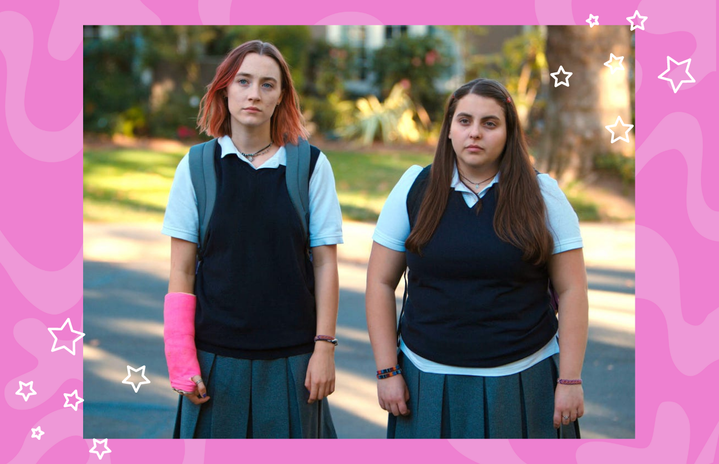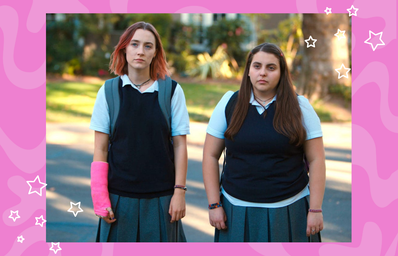Greta Gerwig’s Lady Bird came out in 2017 and since I saw it as a 15-year-old, it has become one of my favourite coming-of-age movies and a regular rewatch. Christine McPherson attends a Catholic high school in Sacramento, California in a post-9/11 United States. Giving herself the name Lady Bird, she longs to escape her mundane and altogether unsatisfactory world so that she can go to the East Coast and experience a “city with culture.” Lady Bird explores the classic themes one would expect from a coming-of-age film, but in line with more modern movies of the genre, it goes beyond the internal struggle to look at external factors that impact a teenager’s personal growth.
Lady Bird is different from her peers as she has pink hair and goes by a name of her own choosing, but more than that, she is separated from them by virtue of her class. Lady Bird is literally from the wrong side of the tracks, living on the other side of a real train track—a physical demarcation of her separation from her peers. Throughout the film, there is no neatly outlined plot or big culminating event to mark the accomplishment of personal growth. Lady Bird is not simply suffering from some personal shortcoming that she must learn to overcome. Instead, real external factors beyond her control impact and inform her growth. The film explores the coming-of-age arc that class imposes upon Lady Bird; her family doesn’t just not accept who she wants to be but they also struggle to reckon with the fact that they might not be able to afford to let her be who she wants to be. The financial struggles that Lady Bird and her family go through aren’t pushed aside and neither are her parents as side characters. We understand their struggles with trying to get Lady Bird to see the reality of their financial situation. Lady Bird doesn’t just need to learn to be kind or more confident as in typical coming-of-age movies, but she and her family must navigate the realities of being financially strained amongst those who aren’t.
This deeper delve into the coming-of-age genre and external forces of growth create space to intricately explore the social dynamic between mother and daughter. By foregoing the classic coming-of-age style of the 90s and early 2000s where the main character grows up by learning a life lesson, Gerwig allows us to explore how class impacts the family dynamic. The relationship between Lady Bird and her parents makes her more complex as a main character. We understand why she wants to assert herself as an individual and why she longs so badly to go to a “city with culture.” Her upbringing with her parents has shaped her and we as an audience get to see this, which isn’t common for the coming-of-age movies of the 90s and 2000s where we seldom even meet them.
By exploring class and social standing, the movie is more well-rounded as a coming-of-age story. It does a better job of reflecting someone’s lived experience because in reality, rarely does anyone go on a personal growth journey on their own, where some major let-down at a party changes their whole worldview. People can relate to arguing with their parents over more than just feeling misunderstood; Lady Bird feels misunderstood but also recognizes how finances are feeding this dynamic. Her father supports her dream of going to college out east and her mother just doesn’t think it’s realistic, as she doesn’t know how they could possibly afford this. This drives arguments between her parents as well. We get to see her parents struggle to help her grow.
The mother-daughter relationship in Lady Bird is touching and heartbreakingly relatable. They go from listening to an audiobook to fighting and one of them jumping out of a moving car in the span of 30 seconds. They love each other but they struggle to understand each other and their respective positions in life. This conflict and navigation of a crucial relationship is essential to coming-of-age in real life. I think this movie touches upon the reality of growing up as an independent person and how that affects your relationship to your parent beautifully. Both Lady Bird and her mother have to find their own space and how they fit together.
Lady Bird has no big “happily ever after” moment. She gets to go to college on the East Coast and she’s starting a new phase of her life on her own, something that she has been yearning deeply for. But the final scene is not one of joy—she is sad. Without words, she acknowledges the importance of her mother in her life and how she is going to need to learn to navigate the world away from home. As university students, this is a relatable feeling. Her story isn’t over, just as no one’s growth as a person is done once they’ve come of age. Lady Bird’s life is just starting, and she’s not magically a complete person now which I think is one of the beautiful elements of the movie as a coming-of-age film. Lady Bird reflects true growth—growth that is never over.



